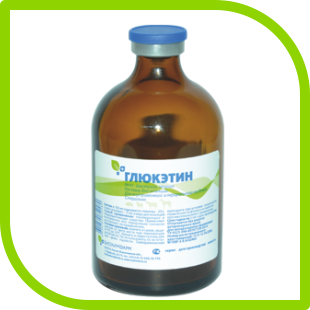INSTRUCTIONS
of using Glucaetin as a tonic and restorative means for animals
(organization-developer: “BioKhimPharm”, Raduzhny, Vladimir region).
I. General information
1. Trade name of the medicinal product: Glucaetin.
International generic name: dextrose, ethanol, ascorbic acid.
2. Dosage form: solution for injection.
Glucaetin contains glucose, rectified ethyl alcohol, ascorbic acid and excipients as active ingredients.
3. Glucaetin is produced packaged in 100 ml in glass sterile bottles, sealed with rubber stoppers, reinforced aluminum caps. Each package is supplied with instructions for use.
4. Glucaetin is stored in a sealed packaging of the manufacturer, separate from food and feed, in a dry place protected from direct sunlight, at temperatures from 00 C to 250 C. The shelf life of Glucaetin under storage conditions is 5 years from the date of production.
Do not use the medication after the expiration date.
5. Glucaetin should be stored out of the reach of children.
6. Dispose of unused medicinal product in accordance with legal requirements.
II. Pharmacological properties
7. Glucaetin refers to the pharmacotherapeutic group of drugs that affect metabolism.
Glucaetin, which contains glucose and ethyl alcohol and ascorbic acid, increases the osmotic blood pressure, activates metabolic processes in the tissues, increases the contractile capacity of the heart muscle, dilates the vessels, improves the antitoxic function of the liver.
Glucaetin in terms of the degree of exposure to the organism of animals refers to substances of low danger (4th hazard class, according to GOST 12.1.007-76).
III. The order of application
8. Glucaetin is used as a general restorative and tonic for blood loss and dehydration of the animal body, for dyspepsia and bronchopneumonia of young animals, in combination with specific treatments.
9. Contraindications for the use of Glucaetin is the individual hypersensitivity of the animal to the components of the drug.
10. Glucaetin is administered to animals either intravenously or intravenously (by drop method) once a day for 3-4 days in the following doses (ml):
for internal use with intravenous administration
• horses – 500-700 70-120
• cows – 400-500 80-100
• calves – 200-300 30-50
• pigs – 200-300 –
• Piglets – 20-50 –
11. Symptoms of overdose in animals have not been identified.
12. Features of the drug during its first use and when it is canceled is not established.
13. Failure to comply with the recommended interval with repeated administration of the drug may lead to a decrease in its effectiveness. If you skip the next dose of the drug, its use is resumed as soon as possible in the same dosage and according to the same scheme.
14. Glucaetin does not cause side effects and complications in recommended doses.
15. The use of Glucetin does not exclude the use of other medicines for etiotropic and pathogenetic therapy.
16. Livestock products are used without restriction during and after application of Glucate.
IV. Personal prevention measures
17. When working with Glucaetin, you should follow the general rules of personal hygiene and safety, provided for when working with medicines.
18. In case of accidental contact with the skin or mucous membranes of the eye, rinse immediately with plenty of water. In case of allergic reactions or accidental ingestion of the drug into the human body, you should immediately contact a medical institution (with you to have instructions for the use of the drug and a label)
19. Vials from Glucaetin are forbidden to use for household purposes, they are subject to recycling with household waste.









